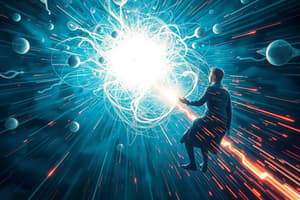Podcast
Questions and Answers
What is force in physics?
What is force in physics?
- The change in position of an object
- The attractive force exerted by a planetary mass
- The movement of an object around an axis
- The interaction between objects that causes them to move (correct)
Which type of force acts directly from one object onto another?
Which type of force acts directly from one object onto another?
- Translational forces
- Contact forces (correct)
- Gravitational forces
- Noncontact forces
How is the effect of gravity described mathematically?
How is the effect of gravity described mathematically?
- $F = G * (m1 * m2) / r$ (correct)
- $F = G / (m1 * m2) * r^2$
- $F = G * (m1 * m2) / r^3$
- $F = G * (m1 + m2) / r^2$
What is torque a measure of in rotational motion?
What is torque a measure of in rotational motion?
In physics, what does motion refer to?
In physics, what does motion refer to?
How does angular momentum differ from torque in rotational motion?
How does angular momentum differ from torque in rotational motion?
Flashcards are hidden until you start studying
Study Notes
Force and Motion is a fundamental concept in physics that describes how objects move when they interact with each other. It involves understanding the relationship between forces acting on an object and its resulting motion.
Force
Force refers to any influence that can change the state of rest or motion of an object. There are three types of force: contact forces, noncontact forces, and gravitational forces. Contact forces act directly from one object onto another, while gravity is a type of noncontact force.
Gravitational Forces
Gravity is the attractive force exerted by a planetary mass (such as Earth) on all other masses in the vicinity. Its effect is described mathematically using the formula F = G * (m1 * m2) / r^2, where 'F' represents the force, 'G' is the gravitational constant, 'm1' is the mass of the first body, 'm2' is the mass of the second body, and 'r' is the distance between their centers.
Motion
Motion refers to any change in position over time. This includes translational motion, which is movement along a straight line, and rotational motion, which is a turn around an axis or pivot point.
Rotational Motion
Rotational motion is more complex because it doesn't follow the linear laws of classical mechanics. Instead, rotational motion follows the principles of angular momentum and torque. Torque is the measure of a force that causes rotation. Angular momentum, on the other hand, is the quantitative measure of rotation.
Newton's Laws of Motion
Newton's laws describe the behavior of forces on objects in terms of acceleration. These laws state that:
- An object will remain at rest or in uniform motion unless acted upon by a net external force.
- The magnitude of the net force acting on an object is equal to the product of the object's mass and acceleration (F=ma), where F represents the force, 'm' is the mass of the object, and 'a' is the acceleration.
- The direction of the net force acting on an object is the same as the direction of the object's acceleration.
These laws help us understand the relationships between forces, masses, and motions in various scenarios.
Studying That Suits You
Use AI to generate personalized quizzes and flashcards to suit your learning preferences.




